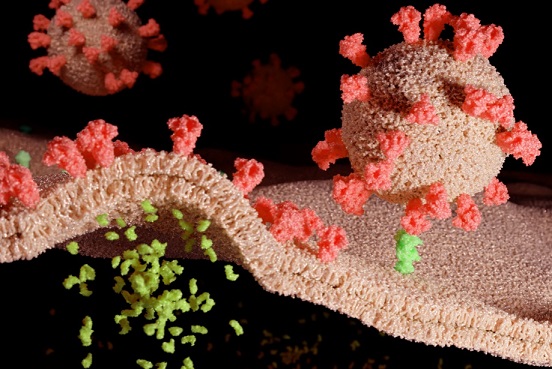How SARS-CoV-2 Hijacks a Critical Human Enzyme to Block Immunity and Supercharge Its Own Replication
Nikhil Prasad Fact checked by:Thailand Medical News Team May 06, 2025 6 months, 4 days, 2 hours, 40 minutes ago
Medical News: Scientists Discover How SARS-CoV-2 Uses a Human Enzyme to Suppress Immunity and Boost Viral Growth
A groundbreaking new study by researchers from the University of Southern California, the University of Texas Health Science Center at San Antonio, and the University of Southern California’s Keck School of Medicine has uncovered a shocking tactic used by the SARS-CoV-2 virus to outsmart the body’s natural immune defenses while enhancing its own ability to replicate.
 How SARS-CoV-2 Hijacks a Critical Human Enzyme to Block Immunity and Supercharge Its Own Replication
How SARS-CoV-2 Hijacks a Critical Human Enzyme to Block Immunity and Supercharge Its Own Replication
This
Medical News report reveals that SARS-CoV-2—the virus responsible for COVID-19—not only weakens the body’s first line of defense known as the interferon response, but also manipulates a critical cellular enzyme called CTP synthetase 1 (CTPS1) to create more of the building blocks it needs to multiply. The study offers powerful new insight into how the virus causes such severe illness and points toward a novel drug strategy that could effectively stop it in its tracks.
Hijacking a Cellular Factory
CTPS1 is a key enzyme inside human cells that helps produce a molecule called CTP, which is essential for building genetic material. The researchers discovered that SARS-CoV-2 hijacks this enzyme to not only ramp up production of CTP—which the virus needs to make copies of itself—but also to interfere with the body’s natural antiviral alarm system.
Under normal conditions, when a virus invades, the body’s cells activate a set of protective proteins known as interferons that help block the spread of the virus. But the study shows that SARS-CoV-2 activates CTPS1 in a way that modifies a critical immune protein known as IRF3. This modification, known as deamidation, prevents IRF3 from turning on the genes that make interferons, effectively silencing the body’s call for help.
Viral proteins such as ORF7b, ORF8, and Nsp8 were identified as the culprits that directly interact with CTPS1, triggering this process.
Turning the Virus’s Trickery Against It
Importantly, the scientists didn’t stop at uncovering the mechanism. They also explored ways to block it. The team screened a series of chemical compounds and found several small molecules—especially one called compound 10—that successfully inhibited CTPS1 activity.
By blocking CTPS1, these compounds restored the body’s interferon response and dramatically reduced the replication of the virus in infected human cells and in animal models. In mice, compound 10 not only slashed the viral load in the lungs but also lessened inflammation and lung damage, offering a promising new path for COVID-19 treatment.
Implications for Future COVID Therapies
This discovery is particularly valuable in light of the virus's ability to rapidly mutate. U
nlike treatments that target the virus itself, targeting a human enzyme like CTPS1 could provide a more durable and mutation-proof approach.
Moreover, because CTPS1 is involved in immune regulation as well as nucleotide synthesis, these inhibitors work on two fronts—restoring the body’s ability to sound the alarm and cutting off the virus’s ability to reproduce. The researchers caution, however, that such treatments must be finely tuned to avoid harming healthy cell functions, especially in fast-dividing immune cells.
Conclusion
The study uncovers a dual-action strategy used by SARS-CoV-2 to disable human immunity and fuel its replication by manipulating CTPS1. It also presents a promising antiviral approach using CTPS1 inhibitors that can both restore immune defenses and block viral growth. This strategy could help overcome the limitations of current antiviral drugs that lose effectiveness against new variants. By targeting a host factor rather than the virus itself, scientists may have discovered a powerful new weapon in the ongoing battle against COVID-19 and potentially other similar viruses.
The study findings were published in the peer reviewed journal: mBio.
https://journals.asm.org/doi/10.1128/mbio.00649-25
For the latest COVID-19 News, keep on logging to Thailand
Medical News.
Read Also:
https://www.thailandmedical.news/news/u-s-nih-study-finds-that-sars-cov-2-infection-of-the-salivary-glands-causes-weakening-of-antifungal-defenses
https://www.thailandmedical.news/news/new-mutation-emerges-in-sars-cov-2-nsp13-protein-that-allows-escape-from-nk-cell-recognition
https://www.thailandmedical.news/news/covid-19-accelerates-brain-and-immune-aging
https://www.thailandmedical.news/articles/coronavirus
https://www.thailandmedical.news/pages/thailand_doctors_listings
https://www.thailandmedical.news/articles/hospital-news
